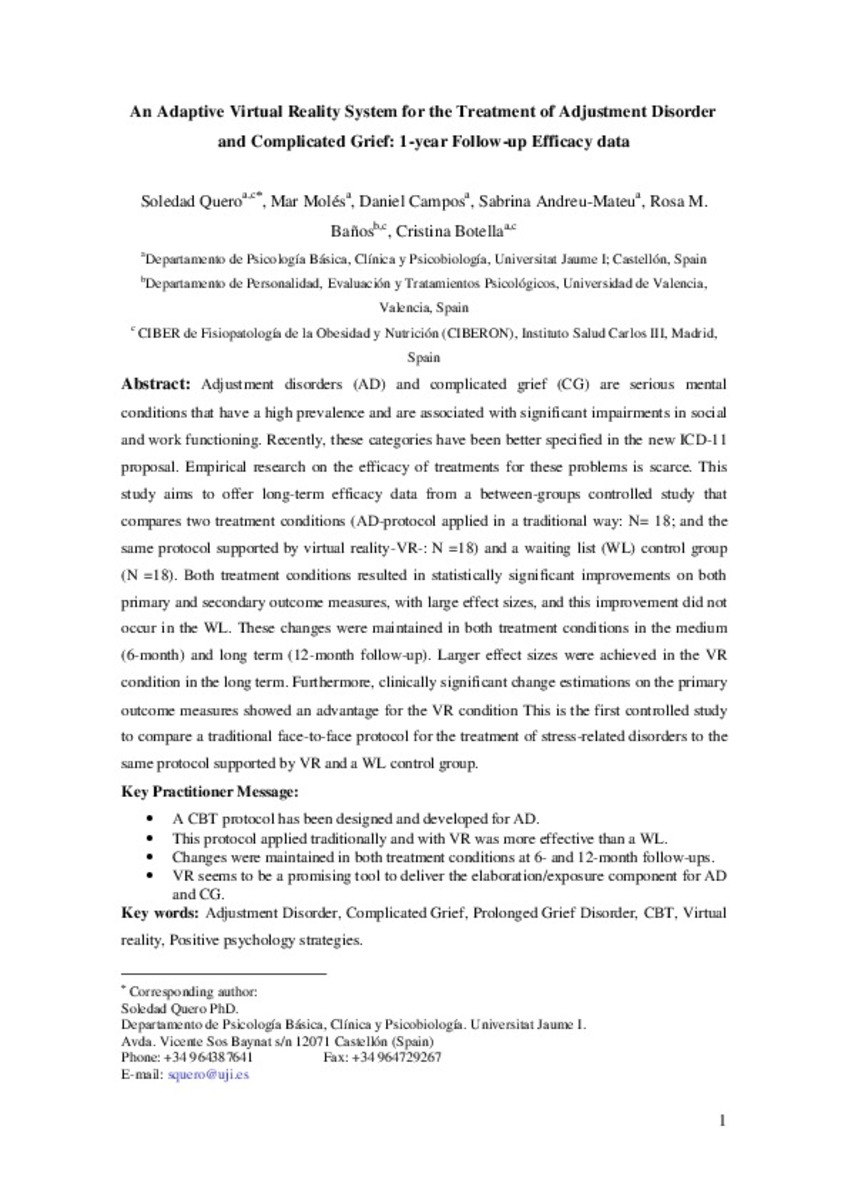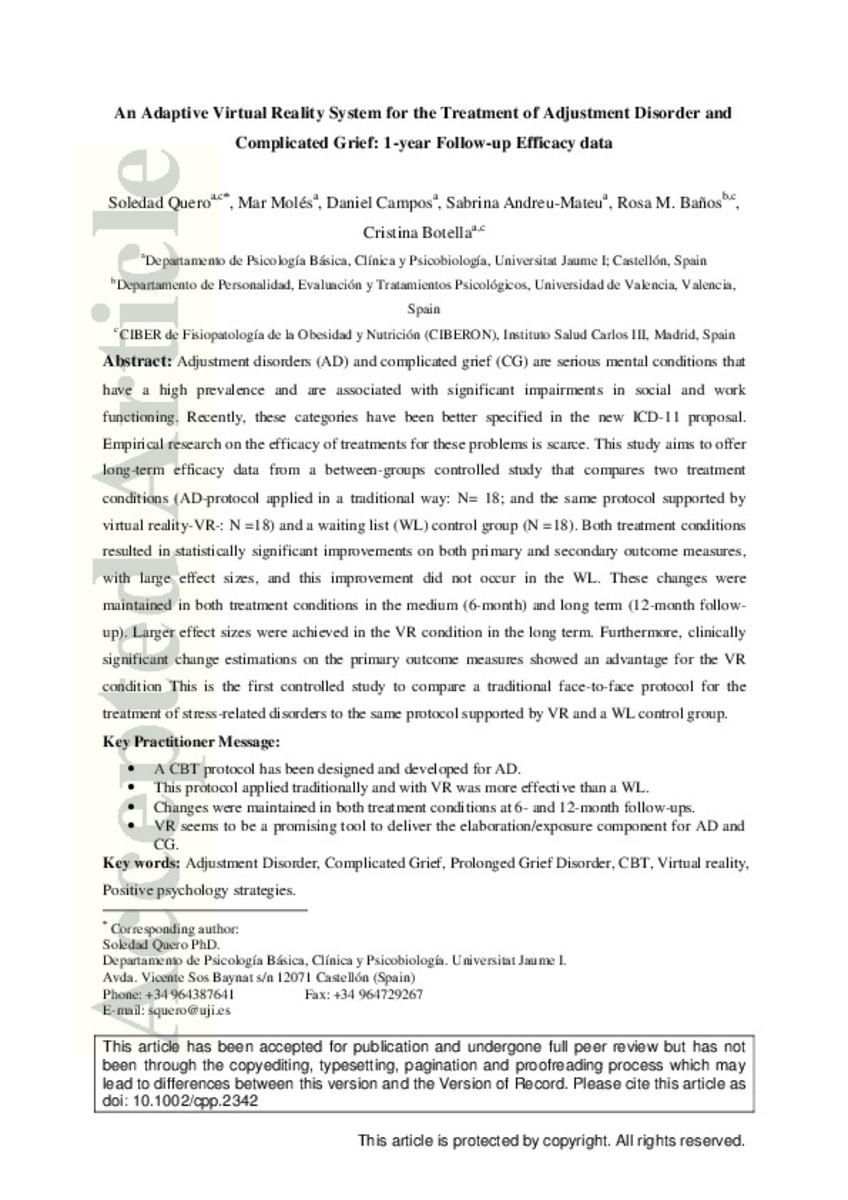Mostrar el registro sencillo del ítem
An adaptive virtual reality system for the treatment of adjustment disorder and complicated grief: 1‐year follow‐up efficacy data
| dc.contributor.author | Quero, Soledad | |
| dc.contributor.author | Molés, Mar | |
| dc.contributor.author | Campos, Daniel | |
| dc.contributor.author | Andreu‐Mateu, Sabrina | |
| dc.contributor.author | Baños, Rosa Maria | |
| dc.contributor.author | Botella, Cristina | |
| dc.date.accessioned | 2019-05-28T07:31:12Z | |
| dc.date.available | 2019-05-28T07:31:12Z | |
| dc.date.issued | 2019 | |
| dc.identifier.citation | QUERO, Soledad, et al. An adaptive virtual reality system for the treatment of adjustment disorder and complicated grief: 1‐year follow‐up efficacy data. Clinical psychology & psychotherapy, 2019, vol. 26, no 2, p. 204-217 | ca_CA |
| dc.identifier.issn | 1063-3995 | |
| dc.identifier.uri | http://hdl.handle.net/10234/182598 | |
| dc.description | This is the pre-peer reviewed version of the following article: An adaptive virtual reality system for the treatment of adjustment disorder and complicated grief: 1‐year follow‐up efficacy data, which has been published in final form at https://doi.org/10.1002/cpp.2342. This article may be used for non-commercial purposes in accordance with Wiley Terms and Conditions for Use of Self-Archived Versions. | |
| dc.description.abstract | Adjustment disorder (AD) and complicated grief (CG) are serious mental conditions that have a high prevalence and are associated with significant impairments in social and work functioning. Recently, these categories have been better specified in the new ICD‐11 proposal. Empirical research on the efficacy of treatments for these problems is scarce. This study aims to offer long‐term efficacy data from a between‐groups controlled study that compares two treatment conditions (AD‐protocol applied in a traditional way: N = 18 and the same protocol supported by virtual reality (VR); VR‐protocol applied in a traditional way: N = 18) and a waiting list (WL) control group (N = 18). Both treatment conditions resulted in statistically significant improvements on both primary and secondary outcome measures, with large effect sizes, and this improvement did not occur in the WL. These changes were maintained in both treatment conditions in the medium (6‐month) and long‐term (12‐month follow‐up). Larger effect sizes were achieved in the VR condition in the long term. Furthermore, clinically significant change estimations on the primary outcome measures showed an advantage for the VR condition This is the first controlled study to compare a traditional face‐to‐face protocol for the treatment of stress‐related disorders with the same protocol supported by VR and a WL control group. | ca_CA |
| dc.format.extent | 14 p. | ca_CA |
| dc.language.iso | eng | ca_CA |
| dc.publisher | Wiley | ca_CA |
| dc.relation.isPartOf | Clinical psychology & psychotherapy, 2019, vol. 26, no 2 | ca_CA |
| dc.rights | Copyright © John Wiley & Sons, Inc. | ca_CA |
| dc.rights.uri | http://rightsstatements.org/vocab/InC/1.0/ | * |
| dc.subject | CBT | ca_CA |
| dc.subject | adjustment disorder | ca_CA |
| dc.subject | complicated grief | ca_CA |
| dc.subject | positive psychology strategies | ca_CA |
| dc.subject | prolonged grief disorder | ca_CA |
| dc.subject | virtual reality | ca_CA |
| dc.title | An adaptive virtual reality system for the treatment of adjustment disorder and complicated grief: 1‐year follow‐up efficacy data | ca_CA |
| dc.type | info:eu-repo/semantics/article | ca_CA |
| dc.identifier.doi | https://doi.org/10.1002/cpp.2342 | |
| dc.relation.projectID | Plan Nacional I+D+I. PSI2013-41783-R / Ministerio de Economia y Competitividad (Spain); P11B2011-20 / Plan 2011 de Promocion de la Investigacion UJI-Proyectos BANCAIXA | ca_CA |
| dc.rights.accessRights | info:eu-repo/semantics/openAccess | ca_CA |
| dc.relation.publisherVersion | https://onlinelibrary.wiley.com/doi/full/10.1002/cpp.2342 | ca_CA |
| dc.type.version | info:eu-repo/semantics/submittedVersion | ca_CA |
Ficheros en el ítem
Este ítem aparece en la(s) siguiente(s) colección(ones)
-
PSB_Articles [1294]
Articles de publicacions periòdiques








